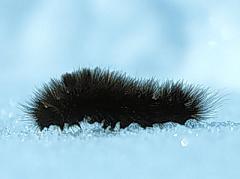Good question, it gets stupid cold in the Arctic.

The average temperature goes down to about 90 degrees below zero, with a windchill factor that will freeze the nuts of a squirrel.
Animals survive the cold with thick warm fur, a lot of body fat, small heads, ears, and tails to reduce heat loss, and hibernating through the winter.
The arctic woolly bear caterpillar uses a few of those strategies, plus some that the mammals haven’t yet figured out. Above its tiny pink legs, the woolly bear is fuzzy to preserve heat and dark to absorb the sun.
That’s not so strange.
However, what is unusual is that it spends at least fourteen years as a caterpillar before reaching adulthood, it is, in fact, the longest-living caterpillar on Earth.
Even stranger, it doesn’t bother trying not to freeze, but instead controls the process by manufacturing glycol within its body.
What normally would happen when fluids inside cells freeze is that the sharp ice crystals rupture the cell’s membranes, killing the cell. Glycol, a type of alcohol sometimes used as an antifreeze for cars, minimizes the size of the crystals and slows down the rate of freezing.
The woolly bear’s body freezes in a systematic pattern. First the gut, then the blood, and then everything else. However, the glycol spares the cytoplasm inside each cell from actually freezing solid.
Antarctic spiders and beetles also make their own glycol to avoid freezer burn.
Through its life, the woolly bear freezes and thaws thirteen times without losing its freshness.
The hungry little caterpillar is only lively and active during the three weeks of the year right before the summer solstice, soaking up the rays on the frozen tundra, grooming its frizzy hair, eating, and growing a little bit more before going back into its icy tundra bed again.
And for what?
Eventually it turns into the moth Arctia caja, lives for part of the arctic summer, mates, lays eggs, and dies.
And so it goes.
Rip Van Woolly Bear.
